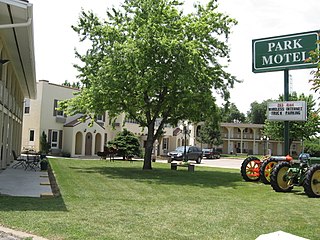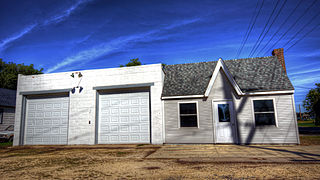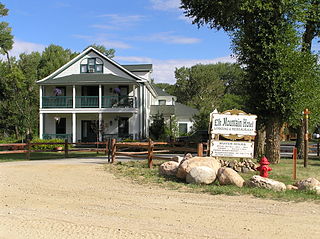
The Lake McDonald Lodge is a historic lodge located within Glacier National Park, on the southeast shore of Lake McDonald. The lodge is a 3-1/2-story structure built in 1913 based on Kirtland Cutter's design. The foundation and first floor walls are built of stone, with a wood-frame superstructure. The lobby is a large, open space that extends to the third story. It has a massive fireplace and a concrete floor scored in a flagstone pattern, with messages in several Indian languages inscribed into it. The rustic lodge was designated a National Historic Landmark in 1987 as one of the nation's finest examples of large-scale Swiss chalet architecture. Lake McDonald Lodge is a member of Historic Hotels of America, the official program of the National Trust for Historic Preservation.

The Weatherford Hotel is a historic hotel in the downtown district of Flagstaff, Arizona. The hotel was established in 1897 by John W. Weatherford, and is located at 23 North Leroux Street, one block north of U.S. Route 66.

The Nachusa House is a former hotel building in Dixon, Illinois, United States along Galena Avenue. The building was constructed in 1853 and operated continuously as a hotel until 1988. It underwent many alterations during the time it operated as a hotel. Following its period as a hotel the five-story mansard roofed building fell into disrepair and was nearly demolished in 1997. The building was restored by the Illinois Housing Development Authority and a Chicago developer at a cost of US$3.2 million and renovated into affordable housing for senior citizens. During its height the Nachusa House was a popular stop along rail and stagecoach lines and was a known layover for Abraham Lincoln. The Nachusa House was added to the U.S. National Register of Historic Places in 1983.

The Hoornbeek Store Complex is a Registered Historic Place in the hamlet of Napanoch, New York, United States. It consists of several buildings located on a one-acre parcel on Main Street between Clinton and Church streets. They reflect Napanoch's transition from its original settlement into the Delaware and Hudson Canal era and the move from Federal style to Greek Revival as the dominant style in American architecture.

The Park Motel is a historic building located in Denison, Iowa, United States. It is an example of a well-preserved highway motel during the early age of motoring. It appears this is also an early example of a motel in Iowa and may be one of the earliest in the Midwest.

The Clover Hill Tavern with its guest house and slave quarters are structures within the Appomattox Court House National Historical Park. They were registered in the National Park Service's database of Official Structures on October 15, 1966.

The Virginian Hotel is a historic hotel in Medicine Bow, Wyoming, United States. Construction on the hotel began in 1901 and was completed in 1911. It was built by August Grimm, the first mayor of Medicine Bow, and his partner George Plummer. The hotel is thought to be named for the famous novel written in Medicine Bow, The Virginian by Owen Wister. Although it provided a place for cowboys and railroad workers to stay while they were in town, the hotel was actually built to serve a much broader clientele. It became a headquarters for all to meet and eat as well as a setting for many business dealings.

The Muscatine Avenue Moffitt Cottage Historic District is a National Register of Historic Places district that includes five stone cottages in Iowa City epitomizing the eccentric vernacular architectural style of Howard Moffitt. Moffitt constructed more than 100 houses in Iowa City and Coralville, Iowa and a few in Citrus City, Texas. These small houses represent one of the regional 20th century vernacular architectural styles in the United States. Howard Moffitt was a prolific builder.

The Clemuel Ricketts Mansion is a Georgian-style house made of sandstone, built in 1852 or 1855 on the shore of Ganoga Lake in Colley Township, Sullivan County, Pennsylvania in the United States. It was home to several generations of the Ricketts family, including R. Bruce Ricketts and William Reynolds Ricketts. Originally built as a hunting lodge, it was also a tavern and post office, and served as part of a hotel for much of the 19th century.

Rogues' Harbor Inn, also known as the Elm Grove Inn and Central Exchange Hotel, is a historic inn and tavern located at Lansing in Tompkins County, New York. It was built between 1830 and 1842 by Major General Daniel D. Minier, and is a three-story brick building in the Greek Revival style. It is a 40-foot-deep by 80-foot-wide rectangular building on a stucco-coated fieldstone foundation with a gable roof. It features a full-width porch with a roof supported by turned posts. The author Grace Miller White (1868–1957) used it as the inspiration for the setting for her novel Judy of Rogues Harbor. It has continued to operate as a bed and breakfast country inn and restaurant. As of January 2019, their website reports "Restaurant reopening Spring 2019."

City Hotel, also known as Seifert's Tavern and the Wheatland Feed Mill, on 214 South Main Street in Wheatland, Iowa was listed on the National Register of Historic Places for Clinton County, Iowa in 2007.

The Hotel Massey is a former hotel in the Downtown district of Bentonville, Arkansas, built in 1910 in the Renaissance Revival architectural style. The historic property replaced the Eagle Hotel, which had been on the site since 1840. Many businesses have occupied the hotel's first floor, and the structure has contained the Bentonville Public Library twice. Coupled with Massey Hotel's community heritage, the building's architectural style is uncommon in Arkansas, and even more rare in the Ozarks. With this duality of significance, the property was added to the National Register of Historic Places in 1978.

Aue Stagecoach Inn is a complex of three structures built by German immigrant Max Aue and is located on Boerne Stage Rd. and I-10, in Leon Springs, county of Bexar, in the U.S. state of Texas. It was added to the National Register of Historic Places in 1979, and is an example of 19th century vernacular architecture of Texas.

Mallett Hall is a historic former hotel building at 2782 Lee Road in Lee, Maine. Built in 1889, it is a rare surviving example of a once-common form, a country hotel in rural Maine. Now owned by the local historical society, it serves as a community function space. It was listed on the National Register of Historic Places in 1993.

Kreinbring Phillips 66 Gas Station is a historic building located in Lowden, Iowa, United States. The Lincoln Highway was established in 1913 and passed through Lowden. In Iowa the highway became U.S. Highway 30 (US 30) in the 1920s. The Tudor Revival-style cottage portion of the service station was built alongside of US 30 in 1934 following the specifications of the Phillips Petroleum Company. The gas pumps were located on a concrete median, no longer extant, in front of the station. August L. Kreinbring was the first owner/operator of the station and he created a park-like setting to the west of the station where highway travelers could relax. New owners built the service bay annex on the park area in 1949. The storage room on the north side of the cottage was added at the same time. The station remained in operation through different owners and brands until 1998. It was listed on the National Register of Historic Places in 2000.

The Sexton Hotel, also known as Hotel Stuart, is a historical building located in Stuart, Iowa, United States. The building is a two-story, L-shaped, brick and brick veneer structure that was built in two parts. The oldest section was a frame building built by John Sexton in 1893 and housed a restaurant. It was moved to the north and the brick hotel wing was built by Sexton in 1907. The older structure, now the north wing of the larger building, was covered with brick veneer. The primary entry into the hotel is located in the canted entrance bay on the southwest corner of the building. There were 28 guest rooms, and the first floor of the north wing housed the dining hall. The first floor also housed a large lobby, the owners quarters, and some of the guest rooms.

The Iowana Hotel, now known simply as The Iowana, is a historic building located in Creston, Iowa, United States. Because Creston was on the mainline of the Chicago, Burlington and Quincy Railroad, and it was a divisional headquarters, it received a steady flow of visitors. Hotels that featured fireproof construction and modern amenities, such as this one, started to enter Iowa's secondary markets in the 1910s and 1920s. A group of local businessmen formed the Hotel Investment Company, and built the hotel. They hired the Chicago architectural firm H.L. Stevens & Company, known for its hotels, to design and build the Iowana. The building was constructed from 1919 to 1920. It served as Creston's primary hotel until about 1958 when more convenient and economical motels were built along the highway. By this time rail travel was declining and highway travel was increasing. The Hotel Investment Company sold the building in 1971. It continued in operation under various owners into the 1980s. The building was listed on the National Register of Historic Places in 2009. It stood vacant for several years until it was transformed into an apartment building.

Aunty Green Hotel is a historic building located in Bonaparte, Iowa, United States. The hotel was built by John Green in 1844. His wife Mary continued to operate the hotel for many years after his death, and that what gave the business its name. It was the second hotel established in town, and it is believed to be the first brick building constructed in Bonaparte. Other businesses that have been housed in this building include a photography studio, doctor's offices, the first local telephone exchange, a creamery and a gas station. The Van Buren County Historical Association rescued the structure from demolition. It is currently owned by the Bonaparte Historical Society and houses the Auntie Green Museum and the public library.

Siebels' Department Store-Boyer Valley Bank, also known as I.0.0.F. Hall, Nicely Building, Whitmore's, and the Rena Barry Building, is a historic building located in Woodbine, Iowa, United States. Siebels' was one of the largest, longest-lasting and most well-known stores in Woodbine. Adolph Siebels moved here from Minden, Iowa in 1904 and bought a grocery store. He expanded the store's offerings to include clothing, housewares and other items. Siebels expanded the store in 1907 and again in 1908. He sold shares in the store to some of his employees in the 1920s, and the store remained in business under three owners until 1954.

The Elk Mountain Hotel, also known as the John S. Evans Hotel, Mountain View Hotel and Grandview Hotel was built in 1905 in Elk Mountain, Wyoming on the bank of the Medicine Bow River. The two-story wood frame building was built next to the 1880 Garden Spot Pavilion, a dance hall that was a social center in an otherwise isolated portion of Wyoming. The hotel was built by John Evans, the owner of the Elk Mountain Saloon, who in 1903 had acquired the Pavilion. Evans catered to the mining trade through the 1930s. By that time better roads allowed tourism to increase, and the hotel provided accommodation to hunters and tourists. Evans sold the property in 1947 to Mark and Lucille Jackson, who remodeled the hotel and the pavilion.























